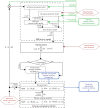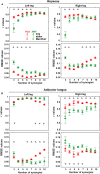Evaluation of Synergy Extrapolation for Predicting Unmeasured Muscle Excitations from Measured Muscle Synergies
- PMID: 33343322
- PMCID: PMC7746870
- DOI: 10.3389/fncom.2020.588943
Evaluation of Synergy Extrapolation for Predicting Unmeasured Muscle Excitations from Measured Muscle Synergies
Abstract
Electromyography (EMG)-driven musculoskeletal modeling relies on high-quality measurements of muscle electrical activity to estimate muscle forces. However, a critical challenge for practical deployment of this approach is missing EMG data from muscles that contribute substantially to joint moments. This situation may arise due to either the inability to measure deep muscles with surface electrodes or the lack of a sufficient number of EMG channels. Muscle synergy analysis (MSA) is a dimensionality reduction approach that decomposes a large number of muscle excitations into a small number of time-varying synergy excitations along with time-invariant synergy weights that define the contribution of each synergy excitation to all muscle excitations. This study evaluates how well missing muscle excitations can be predicted using synergy excitations extracted from muscles with available EMG data (henceforth called "synergy extrapolation" or SynX). The method was evaluated using a gait data set collected from a stroke survivor walking on an instrumented treadmill at self-selected and fastest-comfortable speeds. The evaluation process started with full calibration of a lower-body EMG-driven model using 16 measured EMG channels (collected using surface and fine wire electrodes) per leg. One fine wire EMG channel (either iliopsoas or adductor longus) was then treated as unmeasured. The synergy weights associated with the unmeasured muscle excitation were predicted by solving a nonlinear optimization problem where the errors between inverse dynamics and EMG-driven joint moments were minimized. The prediction process was performed for different synergy analysis algorithms (principal component analysis and non-negative matrix factorization), EMG normalization methods, and numbers of synergies. SynX performance was most influenced by the choice of synergy analysis algorithm and number of synergies. Principal component analysis with five or six synergies consistently predicted unmeasured muscle excitations the most accurately and with the greatest robustness to EMG normalization method. Furthermore, the associated joint moment matching accuracy was comparable to that produced by initial EMG-driven model calibration using all 16 EMG channels per leg. SynX may facilitate the assessment of human neuromuscular control and biomechanics when important EMG signals are missing.
Keywords: EMG normalization; EMG-driven modeling; muscle excitation; muscle synergy; non-negative matrix factorization (NMF); principal component analysis (PCA); stroke.
Copyright © 2020 Ao, Shourijeh, Patten and Fregly.
Conflict of interest statement
The authors declare that the research was conducted in the absence of any commercial or financial relationships that could be construed as a potential conflict of interest.
Figures







Similar articles
-
Comparison of synergy extrapolation and static optimization for estimating multiple unmeasured muscle activations during walking.J Neuroeng Rehabil. 2024 Nov 1;21(1):194. doi: 10.1186/s12984-024-01490-y. J Neuroeng Rehabil. 2024. PMID: 39482723 Free PMC article.
-
EMG-driven musculoskeletal model calibration with estimation of unmeasured muscle excitations via synergy extrapolation.Front Bioeng Biotechnol. 2022 Sep 7;10:962959. doi: 10.3389/fbioe.2022.962959. eCollection 2022. Front Bioeng Biotechnol. 2022. PMID: 36159690 Free PMC article.
-
Comparison of Synergy Extrapolation and Static Optimization for Estimating Multiple Unmeasured Muscle Activations during Walking.bioRxiv [Preprint]. 2024 Mar 6:2024.03.03.583228. doi: 10.1101/2024.03.03.583228. bioRxiv. 2024. Update in: J Neuroeng Rehabil. 2024 Nov 1;21(1):194. doi: 10.1186/s12984-024-01490-y. PMID: 38496460 Free PMC article. Updated. Preprint.
-
Contributions to the understanding of gait control.Dan Med J. 2014 Apr;61(4):B4823. Dan Med J. 2014. PMID: 24814597 Review.
-
Muscle synergies for evaluating upper limb in clinical applications: A systematic review.Heliyon. 2023 May 11;9(5):e16202. doi: 10.1016/j.heliyon.2023.e16202. eCollection 2023 May. Heliyon. 2023. PMID: 37215841 Free PMC article. Review.
Cited by
-
Computational evaluation of psoas muscle influence on walking function following internal hemipelvectomy with reconstruction.Front Bioeng Biotechnol. 2022 Sep 28;10:855870. doi: 10.3389/fbioe.2022.855870. eCollection 2022. Front Bioeng Biotechnol. 2022. PMID: 36246391 Free PMC article.
-
Parameter identification and sensitivity analysis of a lower-limb musculoskeletal model.Front Bioeng Biotechnol. 2025 Apr 14;13:1566381. doi: 10.3389/fbioe.2025.1566381. eCollection 2025. Front Bioeng Biotechnol. 2025. PMID: 40297281 Free PMC article.
-
Comparison of synergy extrapolation and static optimization for estimating multiple unmeasured muscle activations during walking.J Neuroeng Rehabil. 2024 Nov 1;21(1):194. doi: 10.1186/s12984-024-01490-y. J Neuroeng Rehabil. 2024. PMID: 39482723 Free PMC article.
-
Positional Analysis of Assisting Muscles for Handling-Assisted Exoskeletons.Sensors (Basel). 2024 Jul 18;24(14):4673. doi: 10.3390/s24144673. Sensors (Basel). 2024. PMID: 39066070 Free PMC article.
-
EMG-driven musculoskeletal model calibration with estimation of unmeasured muscle excitations via synergy extrapolation.Front Bioeng Biotechnol. 2022 Sep 7;10:962959. doi: 10.3389/fbioe.2022.962959. eCollection 2022. Front Bioeng Biotechnol. 2022. PMID: 36159690 Free PMC article.

